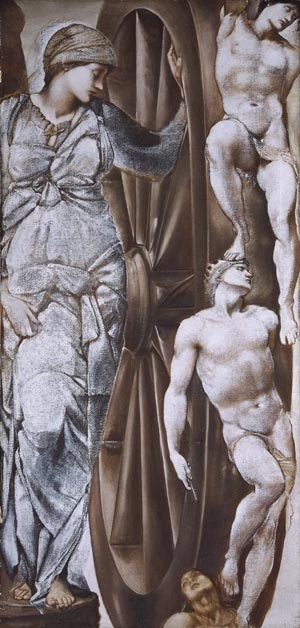Painting Medieval Myths from Rome and Britain
Two different medieval myths are represented in two works by the 19th century artist Sir Edward Burne Jones. The Wheel of Fortune (1882) and Arthur at Avalon (1890) are both in the collections of Amgueddfa Cymru.
This unfinished painting of about 1882 depicts the medieval theme of the wheel of fortune, which lifts or abases man as it is turned by the goddess Fortuna. The drawing of the nudes and the drapery of the goddess reveal the artist's careful study of Michelangelo.
Burne Jones.
Oil on Canvas.
The Wheel of Fortune is based on Roman mythology. For the Romans, the goddess Fortuna represented luck. However during the Middle Ages the idea of the wheel of fortune evolved from the writings of Boethius, a 6th century Christian martyr. In The Consolation of Philosophy, he wrote that the random turns life could take were all part of God's divine will and that man must accept the twists and turns of fortune.
It has long been a tradition in art to show gods as being larger than humans, and here Burne Jones represents Fortune as larger than the humans, who she turns on her wheel. He does show her blindfolded, as was usual, but with her eyes closed. Traditionally, the wheel has four figures on it. They represent four stages of life: "I shall reign", "I reign", "I have reigned" and "I have no kingdom". Burne Jones only depicted three figures on the wheel, but he maintained the idea of a reign by placing a crown on the head of the central figure.
The feminist author Camille Paglia has described this work as a sadomasochistic tableau, with "Fortuna turning her torture wheel of beautiful young men, languid with limbs stretched in sensual suffering". Although the men are accepting of their fate, how much choice do they have? The limbs are not so much stretched in sensuality but as an indication that you ascend by climbing over someone else and this in turn will happen to you. This is something Burne Jones felt personally. In 1893 he wrote "My Fortunes wheel is a true image, and we take our turn upon it, and be broken upon it."
But to wider Victorian society, where industrial fortunes meant one could rise in wealth and class and the British Empire was the most powerful in the world, this notion of rise and fall would have touched a nerve. If you are on top of the wheel, the next turn might place you at the bottom.
Burne Jones painted another myth with Arthur at Avalon. This myth is taken from Thomas Malory's famous poem of 1470 Morte d'Arthur ('The Death of Arthur'). Arthurian legends were popular with artists for many reasons. They were well known to the public and they contained brave knights, thwarted lovers and femmes fatales. Unlike the classical world, these heroes were Christians and, most appealingly, they were rooted in British history. Greece and Rome were all very well but a local hero was more likey to inspire future empire builders.
In Arthur at Avalon Burne Jones shows the scene of Arthur's death. After being mortally wounded in battle by Mordred (his son by his half sister), Arthur is taken to the Isle of Avalon in an attempt to heal his wounds. The name Avalon ("Afallon" in Welsh, meaning the isle of apples) perhaps related to the tree of knowledge, and it was believed to be a magical place. In the background of the painting we can see trees with blossom that could be apple trees. Authur ordered Sir Bedivere to give his sword Excalibur to the Lady in the Lake, but when Bedivere returned Arthur was gone. This has been taken to mean that Arthur might not be dead, only sleeping until he is needed again. The Arthurian legend not only continued to be a source of interest to artists throughout the 19th century, but continues to inspire artists, writers and film-makers today.
Arthur At Avalon, Burne Jones, 1890

